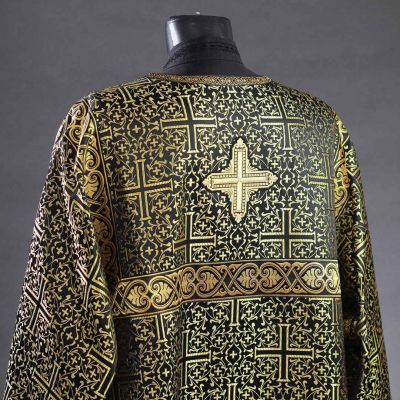This website uses cookies to ensure you get the best experience on our website. Read more
The Dry Well: Pious Disposal Of Sacred Objects
 02Apr
02AprToday we move on to the pious disposal of blessed objects like holy water and sacred gifts. This topic is another key aspect of altar life.
 An example of "clean" washbasin at St.Elisabeth convent: Church of St John of Shanghai
An example of "clean" washbasin at St.Elisabeth convent: Church of St John of Shanghai
We pointed out in our previous post that Saint Elisabeth Convent, like the other parishes and churches of Russian Orthodox church, follows a rule regarding the disposal of first water from garments stained with the Holy Blood, Myrrh or Holy Oil, and other sacred objects. These must be collected in a separate location not connected to the communal sewer. Effluents containing the Holy Gifts should not be mixed with other communal effluents or sewage.
Beyond the motives of reverence and piety, the rule is grounded in several formal regulations and guidelines of the Church.
"The Instructional Message"
As a complement to liturgical texts, "the Instructional Message" discusses what to do when the Holy Gifts fall on the floor, a church garment, or when an insect lands in the Communion Cup. Written centuries ago, it first appeared in the Moscow edition of the Orthodox Service Book of 1699, and up until recently, has been published as an annexe to the pocket-sized edition of the Orthodox service book in Church Slavonic.
The latest versions of the service have come without this annexe to take less space. According to multiple scholars, the key notions of "the instructional message" can be traced to the 16th-century Latin treatise "De defectibus". Despite the Latin roots of the original documents, the practice of the Russian Orthodox Church shares many of the same approaches.
 Book "the Instructional Message" printed in Moscow, 1760
Book "the Instructional Message" printed in Moscow, 1760
The first among the basic principles of the Instructional Message is that the Holy Gifts serve for the sanctification of the human person, and the faithful partake of them by mouth. Any divergence from this rule is considered a grave sin. Extreme care should be taken to avoid any such situations by treating the Holy Gifts with ultimate attention, caution and prudence. Occasionally, however, mishaps will occur.
The Message instructs the priest to take all possible steps to recover the Holy Gifts. Failing that, the object on which the gifts were spilt should be disposed of by burning. The traces of the Holy Gifts should be removed from the vestments by rinsing over a clean vessel.
The exact process may vary depending on the situation, but ultimately the ashes, holy water and other gifts that cannot be recovered must be placed in a location where they cannot be "trampled". The Instructional Message offers several examples such as:
- a river;
- a pit under an altar;
- or a hand-washing basin in the altar (presumed that it is not connected with communal sewage).
Admittedly, few churches stand near a river. It is difficult to speculate about the order of things in the 17th century, but the layout of an altar - historic and modern - precludes the performance of any major works underneath. The designs of the church and the floor are also not conducive to building a drainage channel or putting up a basin.
Consequently, most churches have opted for a dry well (also called a clean well).
 A draft scheme of a dry well
A draft scheme of a dry well
The design of a dry well
The dry well is a free-standing structure not connected to general or communal sewage. It is usually located close to the Church and has reinforced and, where necessary, insulated walls. It is an isolated drainage well not connected to the disposal systems for household, municipal waste or rainwater sewerage.
Commonly, it is built as close to the church as possible. Depending on the climate, it may be deeper than the freezing level, but not deeper than the subsoil water level. At a minimum, the well receives drainage from the altar washbasin, and frequently, from the stationary baptisterium, church vestry, or any other area designated for the washing of the church vestments. Usually, the clean well is covered by a lid with a cross on its top.
 An external dry well (see, the door is locked)
An external dry well (see, the door is locked)
To summarise, a clean well - as an object isolated from all household and sewage waste - is used for pious disposal of all sacred objects, including holy water from the sacrament of baptism, effluents from the washing of church vessels and blessed objects, and the washing of Communion cloths.
Ashes from burned prayer notes, icons, Prosphoras, altar linens, chasubles and dust from the altar floor are placed in the clean well through a designated door. A designated furnace is sometimes put in place to dispose of sacred objects by burning them. "The Instructional Message" gives the following guidance: "Dust from the altar and church floor should not be stored in inappropriate places; only put it in a river or a place where it cannot be trampled with the feet."
Benefits
From my experience, I can testify that a clean washbasin in the sanctuary offers multiple advantages.
For example, small children may accidentally overturn a holy vessel and spill the Holy Blood on their clothes. In that case, the stain can be washed under a stream of water in an altar washbasin. Without the washbasin, one would have to wait for the stain to dry, and then destroy the stained garment by burning, an expensive and time-consuming process.
The altar cloth over the sacrificial table accumulates multiple crumbs from the holy bread that are almost impossible to collect. Shaking them off over the clean washbasin is a convenient solution.
The clergy commonly use the altar washbasin to wash their hands and mouths before and after giving Communion and preparing the Holy Gifts for the Liturgy of Presanctified Gifts.
The washbasin is also convenient for washing the used communion cloth if there is not a clean one to replace it.
 A "clean" washbasin in the Church in honour of the Holy Royal Martyrs at St.Elisabeth Convent
A "clean" washbasin in the Church in honour of the Holy Royal Martyrs at St.Elisabeth Convent
But what if there is no way to build a clean well?
Admittedly, the layout of the place of worship is not always conducive to the construction of a full-fledged clean well. Sometimes, this possibility is ignored at the design stage. However, there are always options.
In one makeshift church where I happened to serve, they used a washbowl. An altar servant held it out before the priest, almost as if he were an archbishop! In another church, they dug a drain under the altar (the floors were wooden).
Where that is not possible, a small barrel with a tight lid can be used. Eventually, however, it will still need to be emptied in some location "not trampled by the feet" and designated exclusively for the disposal of sacred objects.
It is always important to treat sacred objects with the utmost care, piety, reverence, attention and prudence. These considerations should always remain at the top of any clergyman's mind, along with the pious disposal of sacred objects.





















